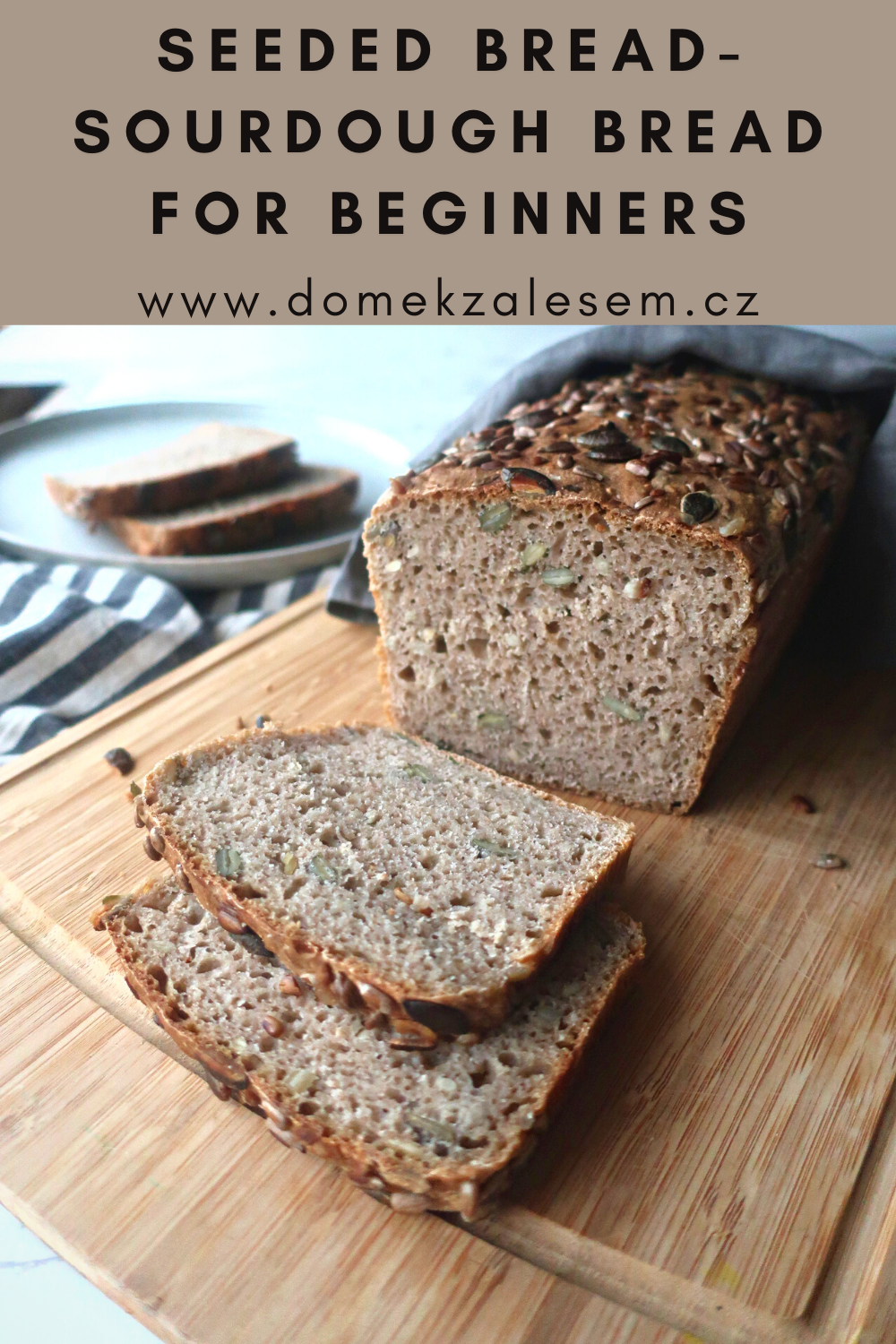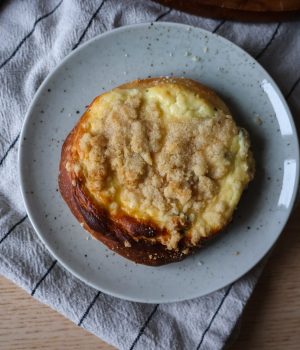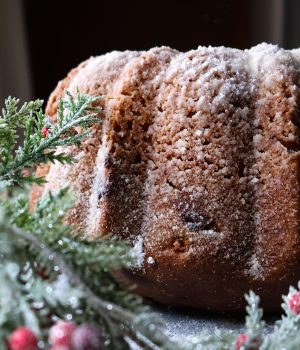Seeded bread - sourdough bread for beginners

The easiest and most delicious sourdough bread recipe not only for beginners! It is full of seeds, with a soft crumb and crispy crust and will make your whole home smell amazing.
When I first started baking sourdough bread, I didn't have much success. I tried one recipe after another and none of them worked! Everything seemed to be too complicated and so confusing. I finally learned how to work with sourdough with this simple recipe. And I named it Seeded bread. Because the bread is full of nutritious seeds, which we just love.
If you're also a sourdough beginner who's a bit lost, try this recipe! It will definitely point you in the right direction. I've described everything in detail in the instructions and photographed each step. And just to be sure, I've included a detailed instruction on how to make the levain.

Why is this Seeded bread so easy to make?
In this recipe, the dough is only mixed with a wooden spoon in a bowl, so it is a no-knead recipe and there is no folding or shaping the dough. Just super easy to make! The dough is more hydrated, hence unformable, and is baked in a loaf tin, which is how it gets its shape. It's an absolutely perfect bread and is still baked regularly in our house too. And it's always when I don't have the time or feel like caring more about the dough. Which is actually quite often... Just a great bread that you'll love to have in your arsenal too. Besides, this recipe is great to remember.
What is a levain?
Levain is a mixture of flour, water and sourdough starter, which is fermented for 8-12 hours and later mixed with the ingredients for the dough. It is mainly used in bread making, where it is necessary to have the right ratio of levain to the rest of the flour for the bread to rise well and hold its shape.
Try also my other simple sourdough recipes:

What flour to use for this Seeded bread?
In this recipe I use whole wheat rye flour, which I use for sourdough levain. However, you can also use whole wheat flour, which absorbs about the same amount of water. For the dough I use a combination of wheat and rye bread flour.
You can also add a handful of buckwheat flour, white wheat flour or different ancient varieties of wheat such as red wheat, einkorn or kamut. If you only put a small amount of these "unusual" flours, the recipe will always work great. By the way, this is a great way to learn how to work with other flours over time, because you will see how they change the dough and the end result - bread.
The fact that the dough is more hydrated makes it tolerate different flour swaps, because in the end the most important thing is that the dough has a similar or the same consistency as you see in the method in the picture. So feel free to experiment.

How to make Seeded bread - sourdough bread for beginners?
First day: In the evening, prepare the sourdough levain by mixing 75 g of wholemeal rye flour, 75 g of water and 1 tbsp (25 g) of sourdough starter. Mix well with a spoon and use a spatula to wipe the dough from the edges of the bowl and from the spoon to form a uniform mound. Cover with a plastic bag, wrap or a cling film. Let it ferment overnight at room temperature for about 10-12 hours. The fermented levain should be full of bubbles and still retains a slightly bulging shape.





The next day: In the morning add in a big bowl, 100 g of rye bread flour, 250 g of wheat bread flour, 60-70 g of seeds and 10 g of salt. Stir very well. Add 11 g of salt to the flour and mix with a wooden spoon. The amount of water is only approximate. It is always better to add water little by little, as each flour absorbs water differently. It is best to check the consistency of the resulting dough, which should be able to be stirred with a wooden spoon but should still resist it.
Use the whole levain in the dough or you can take 1 tbsp from it into a glass container with a lid in the morning, depending on how you maintain your starter. I'll be writing a post about my easy and carefree sourdough starter maintenance soon!
Cover the bowl with the dough again with a plastic bag or cling film and leave in a warm place to rise for approximately 4 hours without disturbing. During this time the dough will rise by approximately ⅓ of its volume.




Then prepare a loaf tin of size 8x18x8 cm. This can be lined with baking paper or brushed with oil (I use unscented coconut oil).


Carefully transfer the risen dough into the loaf tin and smooth the top with a wet spatula. Immediately sprinkle with the seed mixture, while the top is still wet, so that the seeds stick well to the dough. Cover with a plastic wrap. Let it rise for the second time in the loaf tin for about 2 hours. When properly risen, the dough should just below the edge of the loaf tin.


Bake the bread in a hot oven at 210°C for approximately 45 minutes. After baking, carefully remove the bread from the loaf tin and transfer to a wire rack to cool. The bread may be slightly stuck on the sides, so it is a good idea to use a spatula or a knife and run it between the loaf tin and the bread to loosen the stuck spots. If you have used baking paper, remove the paper from the bread as soon as possible.
Let the Seeded bread cool on a wire rack for at least 1 hour before slicing.

How to plan the baking of wheat sourdough bread?
- First day in the evening: 20:00, prepare the sourdough levain. Let it ferment overnight at room temperature.
- The next morning: 7:00, add the rest of ingredients in a bowl and mix the dough.
- around 11:00: prepare a loaf tin and add in the risen dough, sprinkle with seeds and let is rise for the second time
- around 13:00 : heat the oven on 210°C
- around 13:30 the dough is risen, bake it for 45 minutes in a preheated oven
- 14:15 the bread is baked so remove it from the loaf tin and put it on a cooling rack (without baking paper)
TIPS:
What can I add into Seeded bread?
My favorites are sunflower seeds, pumpkin seeds and ground flax seeds . But you can use different combinations of seeds and nuts. You can even let your imagination run wild and add chopped sun-dried tomatoes, olives, herbs, bread spices, fried onions, cooked grains, flakes or dried fruit. Part of the water can be swapped out for milk or buttermilk or a little grated cooked potato or vegetable puree. I tried adding 2 tbsp of pumpkin puree a couple of times and together with the pumpkin seeds, the bread was perfect with a wonderfully crispy crust!
Recipe

Recipe for 1 loaf
Seeded bread - sourdough bread for beginners
Ingredients:
for levain:
- 75 g rye wholemeal flour
- 75 g water at room temperature
- 1 tbsp (25 g) sourdough starter, it can be cold straight from the fridge
for dough:
- 100 g rye bread flour
- 250 g wheat bread flour
- 10 g salt
- 60 - 70 g seeds ( + more for sprinkling)
- 300 g water, approximately
Instructions:
- First day: In the evening, prepare the sourdough levain by mixing 75 g of wholemeal rye flour, 75 g of water and 1 tbsp (25 g) of sourdough starter. Cover with a plastic bag, wrap or a cling film. Let it ferment overnight at room temperature for about 10-12 hours. The fermented levain should be full of bubbles and still retains a slightly bulging shape.
- The next day: In the morning add in a big bowl, 100 g of rye bread flour, 250 g of wheat bread flour, 60-70 g of seeds and 10 g of salt. Stir very well. Add 11 g of salt to the flour and mix with a wooden spoon. The amount of water is only approximate. (If you need to, don't forget to add 1 tbsp of levain into a jar for the next baking.)
- Cover the bowl with the dough again with a plastic bag or cling film and leave in a warm place to rise for approximately 4 hours without disturbing. During this time the dough will rise by approximately ⅓ of its volume.
- Then prepare a loaf tin of size 8x18x8 cm. This can be lined with baking paper or brushed with oil (I use unscented coconut oil).
- Carefully transfer the risen dough into the loaf tin and smooth the top with a wet spatula. Immediately sprinkle with the seed mixture, while the top is still wet, so that the seeds stick well to the dough. Cover with a plastic wrap. Let it rise for the second time in the loaf tin for about 2 hours. When properly risen, the dough should just below the edge of the loaf tin.
- Bake the bread in a hot oven at 210°C for approximately 45 minutes. After baking, carefully remove the bread from the loaf tin and transfer to a wire rack to cool. If you have used baking paper, remove the paper from the bread as soon as possible.
- Let the Seeded bread cool on a wire rack for at least 1 hour before slicing.
You may also like:
- All Post
- Sourdough
- Natural living
- Cooking from scratch
- Back
- Breakfast
- Soups
- Breads
- Dessert
- Main dishes
- Others
- Sides




Dobrý den, Radko,
právě mi kyne tento chlebík, ale mám mnohem větší formu, než uvádíte. Těsta se tedy zdálo dost, tak snad nebude úplně placatý. Mohla bych poprosit na typ, kde sehnat formu o rozměrech 8x18x8cm? Google takovou nenašel, nebo hledám špatně. Ráda bych zkusila další recepty od Vás, kde tuto formu používáte – třeba žitný chleba.
Díky moc!
Dobrý den, Těsto by mělo poměrně dost nakynout, kdyžtak příště udělejte z dvojnásobné dávky. Menší formy na chleba se vyrábí v různých rozměrech. Stačit vám bude jakákoliv o objemu cca 450 ml. Na internetu určitě najdete formy o rozměrech 15x9x7 cm, což je velmi podobné. 🙂
Dobrý den, díky za odpověď. Chlebík je výborný, jen je trochu nižší, než ten Váš, ale vzhledem k tomu jak rychle zmizel, menší forma asi nebude potřeba, spíš ta dvojitá dávka 🙂 Je to od Vás již 4.recept co zkouším a všechny jsou luxusní. Už vybírám, který recept zkusím příště!
Díky moc za rady a inspiraci, pro „kváskaře“ začátečníka je to velká pomoc.
Dobrý den Radko, ráda peču semínkový chleba podle vašeho receptu. Recept jsem si upravila z jedné a půl dávky , podle velikosti formy. Chleba se pokaždé povede, ale střídka je dosti lepivá. Nevím proč, Jestli je to množstvím kvásku ten jsem také navýšila na 1,5 dávky.
Mouku střídám podle toho jakou zrovna mám, nejčastěji dávám chlebovou pšeničnou a menší množství špaldové hladké. Kvásek krmím celozrnou žitnou hladkou.
Děkuji za radu.
Dobrý den, ano toto těsto je hodně hydratované a je možné, že používáte mouku, která saje méně vody než ta moje. Určitě bych vyzkoušela část vody ubrat a přidávat opravdu postupně. 🙂
Dobrý večer, jde prosím používat normální hladkou pšeničnou místo pšeničné chlebové? Děkuji
Ano, lze použít i běžnou pšeničnou mouku 🙂
Dobrý den, mam větší formu než vy, Ráďo. Chci se zeptat, kdyz budu dělat z dvojité dávky, tak dam na rozkvas: 2PL kvásku, 150 mouky a 150 vody?
Předem děkuji za odpověď.
Ano přesně tak to dělám 🙂
Tenhle chleba nemá konkurenci – pečeme ho už pravidelně 🙂
<3